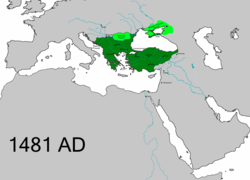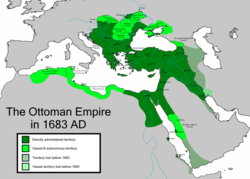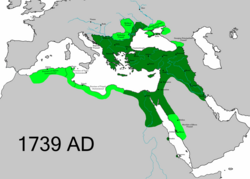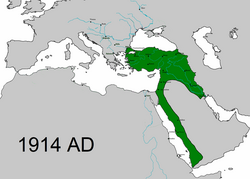Empayar Ottoman,[lower-alpha 10] tau dikelala mega enggau nama Empayar Turki,[24][25] ranah empayar[lower-alpha 11] bepalan ba Anatolia ti mungkur mayuh endur ba Eropah Tenggara, Asia Barat, enggau Afrika Utara ari abad ke-14 ngagai pun abad ke-20; iya mega nguasa sekeda endur ba tenggara Eropah Tengah entara pun abad ke-16 enggau pun abad ke-18.[26][27][28]
Penerang
- ↑ McDonald, Sean; Moore, Simon (2015-10-20). "Communicating Identity in the Ottoman Empire and Some Implications for Contemporary States". Atlantic Journal of Communication. 23 (5): 269–283. doi:10.1080/15456870.2015.1090439. ISSN 1545-6870. S2CID 146299650. Diarkib ari asal ba 14 January 2023. Diambi 24 March 2021.
- ↑ Shaw, Stanford; Shaw, Ezel (1977). History of the Ottoman Empire and Modern Turkey. Vol. I. Cambridge University Press. p. 13. ISBN 978-0-521-29166-8.
- ↑ Atasoy & Raby 1989, p. 19–20.
- ↑ 4.0 4.1 "In 1363 the Ottoman capital moved from Bursa to Edirne, although Bursa retained its spiritual and economic importance." Ottoman Capital Bursa Archived 5 March 2016 at the Wayback Machine. Official website of Ministry of Culture and Tourism of the Republic of Turkey. Retrieved 26 June 2013.
- ↑ 5.0 5.1 Edhem, Eldem (21 May 2010). "Istanbul". In Gábor, Ágoston; Masters, Bruce Alan (eds.). Encyclopedia of the Ottoman Empire. Infobase. p. 286. ISBN 978-1-4381-1025-7.
With the collapse of the Ottoman Empire and the establishment of the Republic of Turkey, all previous names were abandoned and Istanbul came to designate the entire city.
- ↑ Shaw, Stanford J.; Shaw, Ezel Kural (1977b). History of the Ottoman Empire and Modern Turkey. Vol. 2: Reform, Revolution, and Republic: The Rise of Modern Turkey 1808–1975. Cambridge University Press. doi:10.1017/CBO9780511614972. ISBN 9780511614972.
- ↑ Shaw & Shaw 1977b, p. 386, volume 2; Robinson (1965). The First Turkish Republic. p. 298.; Society (2014-03-04). "Istanbul, not Constantinople". National Geographic Society. Diarkib ari asal on 7 July 2020. Diambi 2019-03-28.)
- ↑ Inan, Murat Umut (2019). "Imperial Ambitions, Mystical Aspirations: Persian Learning in the Ottoman World". In Green, Nile (ed.). The Persianate World: The Frontiers of a Eurasian Lingua Franca. University of California Press. pp. 88–89.
As the Ottoman Turks learned Persian, the language and the culture it carried seeped not only into their court and imperial institutions but also into their vernacular language and culture. The appropriation of Persian, both as a second language and as a language to be steeped together with Turkish, was encouraged notably by the sultans, the ruling class, and leading members of the mystical communities.
- ↑ Tezcan, Baki (2012). "Ottoman Historical Writing". In Rabasa, José (ed.). The Oxford History of Historical Writing: Volume 3: 1400-1800 The Oxford History of Historical Writing: Volume 3: 1400-1800. Oxford University Press. pp. 192–211.
Persian served as a 'minority' prestige language of culture at the largely Turcophone Ottoman court.
- ↑ Flynn, Thomas O. (2017). The Western Christian Presence in the Russias and Qājār Persia, c.1760–c.1870. BRILL. p. 30. ISBN 978-90-04-31354-5. Diarkib ari asal ba 14 January 2023. Diambi 21 October 2022.
- ↑ Fortna, B. (2012). Learning to Read in the Late Ottoman Empire and the Early Turkish Republic. Springer. p. 50. ISBN 978-0-230-30041-5. Diarkib ari asal ba 21 October 2022. Diambi 21 October 2022.
Although in the late Ottoman period Persian was taught in the state schools...
- ↑ Spuler, Bertold (2003). Persian Historiography and Geography. Pustaka Nasional Pte. p. 68. ISBN 978-9971-77-488-2. Diarkib ari asal ba 14 January 2023. Diambi 21 October 2022.
On the whole, the circumstance in Turkey took a similar course: in Anatolia, the Persian language had played a significant role as the carrier of civilization. [...] where it was at time, to some extent, the language of diplomacy [...] However Persian maintained its position also during the early Ottoman period in the composition of histories and even Sultan Salim I, a bitter enemy of Iran and the Shi'ites, wrote poetry in Persian. Besides some poetical adaptations, the most important historiographical works are: Idris Bidlisi's flowery "Hasht Bihist", or Seven Paradises, begun in 1502 by the request of Sultan Bayazid II and covering the first eight Ottoman rulers...
- ↑ Fetvacı, Emine (2013). Picturing History at the Ottoman Court. Indiana University Press. p. 31. ISBN 978-0-253-00678-3. Diarkib ari asal ba 21 October 2022. Diambi 21 October 2022.
Persian literature, and belles-lettres in particular, were part of the curriculum: a Persian dictionary, a manual on prose composition; and Sa'dis 'Gulistan', one of the classics of Persian poetry, were borrowed. All these titles would be appropriate in the religious and cultural education of the newly converted young men.
- ↑ Yarshater, Ehsan; Melville, Charles, eds. (359). Persian Historiography: A History of Persian Literature. Vol. 10. Bloomsbury. p. 437. ISBN 978-0-85773-657-4. Diarkib ari asal ba 21 October 2022. Diambi 21 October 2022.
Persian held a privileged place in Ottoman letters. Persian historical literature was first patronized during the reign of Mehmed II and continued unabated until the end of the 16th century.
- ↑ Inan, Murat Umut (2019). "Imperial Ambitions, Mystical Aspirations: Persian learning in the Ottoman World". In Green, Nile (ed.). The Persianate World The Frontiers of a Eurasian Lingua Franca. University of California Press. p. 92 (note 27).
Though Persian, unlike Arabic, was not included in the typical curriculum of an Ottoman madrasa, the language was offered as an elective course or recommended for study in some madrasas. For those Ottoman madrasa curricula featuring Persian, see Cevat İzgi, Osmanlı Medreselerinde İlim, 2 vols. (Istanbul: İz, 1997),1: 167–69.
- ↑ Ayşe Gül Sertkaya (2002). "Şeyhzade Abdurrezak Bahşı". In György Hazai (ed.). Archivum Ottomanicum. Vol. 20. pp. 114–115. Diarkib ari asal ba 24 October 2022. Diambi 23 October 2022.
As a result, we can claim that Şeyhzade Abdürrezak Bahşı was a scribe lived in the palaces of Sultan Mehmed the Conqueror and his son Bayezid-i Veli in the 15th century, wrote letters (bitig) and firmans (yarlığ) sent to Eastern Turks by Mehmed II and Bayezid II in both Uighur and Arabic scripts and in East Turkestan (Chagatai) language.
- ↑ 17.0 17.1 Strauss, Johann (2010). "A Constitution for a Multilingual Empire: Translations of the Kanun-ı Esasi and Other Official Texts into Minority Languages". In Herzog, Christoph; Malek Sharif (eds.). The First Ottoman Experiment in Democracy. Würzburg: Orient-Institut Istanbul. pp. 21–51. Diarkib ari asal ba 11 October 2019. Diambi 15 September 2019. (info page on book Archived 20 September 2019 at the Wayback Machine at Martin Luther University) // CITED: p. 26 (PDF p. 28): "French had become a sort of semi-official language in the Ottoman Empire in the wake of the Tanzimat reforms.[...] It is true that French was not an ethnic language of the Ottoman Empire. But it was the only Western language which would become increasingly widespread among educated persons in all linguistic communities."
- ↑ Cite error: Invalid
<ref>tag; no text was provided for refs namedLambton-1995 - ↑ Pamuk, Şevket (2000). A Monetary History of the Ottoman Empire. Cambridge University Press. pp. 30–31. ISBN 0-521-44197-8. Diarkib ari asal ba 14 January 2023. Diambi 21 October 2022.
The Ottomans began to strike coins in the name of Orhan Bey in 1326. These earliest coins carried inscriptions such as "the great Sultan, Orhan son of Osman" [...] Ottoman historiography has adopted 1299 as the date for the foundation of the state. 1299 might represent the date at which the Ottomans finally obtained their independence from the Seljuk sultan at Konya. Probably, they were forced at the same time, or very soon thereafter, to accept the overlordship of the Ilkhanids [...] Numismatic evidence thus suggest that independence did not really occur until 1326.
- ↑ 20.0 20.1 20.2 Rein Taagepera (September 1997). "Expansion and Contraction Patterns of Large Polities: Context for Russia". International Studies Quarterly. 41 (3): 498. doi:10.1111/0020-8833.00053. ISSN 0020-8833. JSTOR 2600793. Diarkib ari asal ba 19 November 2018. Diambi 8 July 2019.
- ↑ Turchin, Peter; Adams, Jonathan M.; Hall, Thomas D (December 2006). "East-West Orientation of Historical Empires". Journal of World-Systems Research. 12 (2): 223. ISSN 1076-156X. Diarkib ari asal ba 20 May 2019. Diambi 12 September 2016.
- ↑ Erickson, Edward J. (2003). Defeat in Detail: The Ottoman Army in the Balkans, 1912–1913. Greenwood Publishing Group. p. 59. ISBN 978-0-275-97888-4.
- ↑ Strauss, Johann (2010). "A Constitution for a Multilingual Empire: Translations of the Kanun-ı Esasi and Other Official Texts into Minority Languages". In Herzog, Christoph; Malek Sharif (eds.). The First Ottoman Experiment in Democracy. Würzburg: Orient-Institut Istanbul. pp. 21–51. Diarkib ari asal ba 11 October 2019. Diambi 15 September 2019. (info page on book Archived 20 September 2019 at the Wayback Machine at Martin Luther University) // CITED: p. 36 (PDF p. 38/338)
- ↑ P., E. A. (1916). "Review of The Caliph's Last Heritage: A Short History of the Turkish Empire". The Geographical Journal. 47 (6): 470–472. doi:10.2307/1779249. ISSN 0016-7398. JSTOR 1779249. Diarkib ari asal ba 10 July 2022. Diambi 10 July 2022.
- ↑ Baykara, Prof. Tuncer (2017). "A Study into the Concepts of Turkey and Turkistan which were used for the Ottoman State in XIXth Century". Journal of Atatürk and the History of Turkish Republic. 1: 179–190. Diarkib ari asal ba 26 January 2024. Diambi 26 March 2024.
- ↑ Ingrao, Charles; Samardžić, Nikola; Pešalj, Jovan, eds. (2011-08-12). The Peace of Passarowitz, 1718. Purdue University Press. doi:10.2307/j.ctt6wq7kw.12. ISBN 978-1-61249-179-0. JSTOR j.ctt6wq7kw. Diarkib ari asal ba 20 December 2023. Diambi 26 December 2023.
- ↑ Szabó, János B. (2019). "The Ottoman Conquest in Hungary: Decisive Events (Belgrade 1521, Mohács 1526, Vienna 1529, Buda 1541) and Results". The Battle for Central Europe. Brill. pp. 263–275. doi:10.1163/9789004396234_013. ISBN 978-90-04-39623-4. Diambi 2023-12-19.
- ↑ Moačanin, Nenad (2019). "The Ottoman Conquest and Establishment in Croatia and Slavonia". The Battle for Central Europe. Brill. pp. 277–286. doi:10.1163/9789004396234_014. ISBN 978-90-04-39623-4. Diarkib ari asal ba 15 January 2024. Diambi 2023-12-19.
Cite error: <ref> tags exist for a group named "lower-alpha", but no corresponding <references group="lower-alpha"/> tag was found






